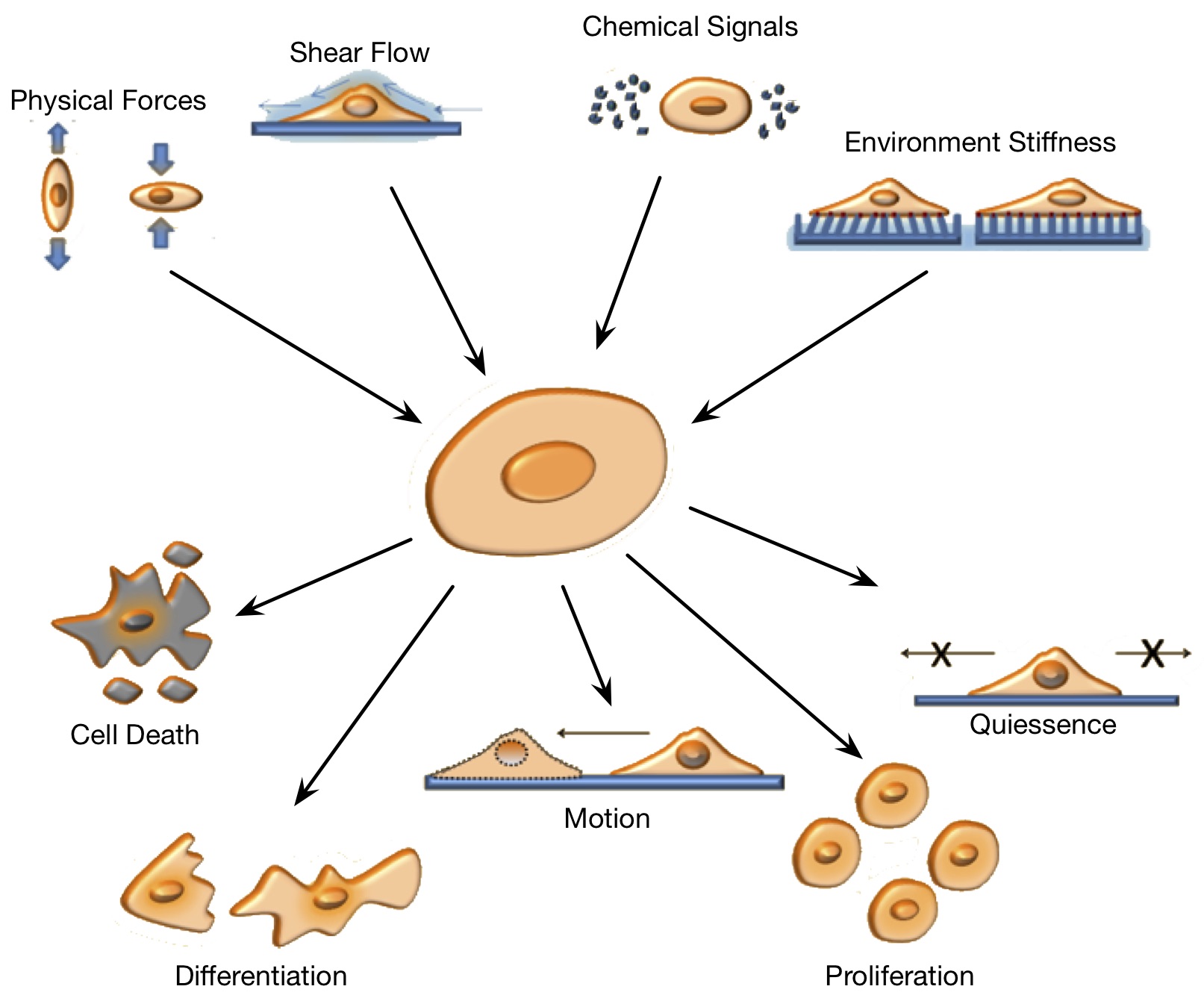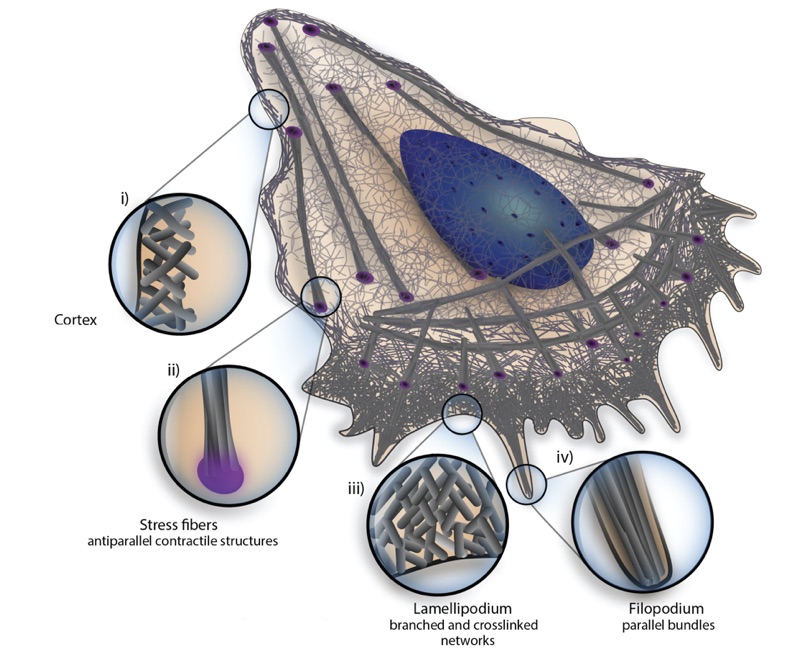Formalizing Physical Knowledge¶
The first step in formalizing knowledge is writing it down in such a way that it has semantic meaning for both humans and computers. In order to specify biological phenomena, we need a modeling description that corresponding closely to natural phenomena.
Let’s start by looking at the folliwing diagram of a single biological cell. This cell could be moving on a surface, or inside some tissue.
We can imedietly idenfity a number of things. Things such as cell nuclie, cell membrane, cytoplasm, actin fibers, lamellpoidium, filopodium, etc.. We call these things objects. Objects represent the “things” such as molecules, proteins, cells, fluids, or materials. We define an object as any instantiable physical or logical entity that has certain state-full or structural properties.
We also understand that for any living or active things, these objects typically not static. Cells can move around, active fibers contract, cells can excert forces on it’s neighboring cells and enviormnet, cells can sense and respond with chemical signaling, and so forth as in the following figure

Fig. 18 Biological cells can sense a variaety of signals in their envionrment and respond with a variety of behaviors.
We call anything that causes something to change a process. Processes represent anything that causes a change in state. A process may, for example, represent a transformation in which sub-strates are consumed and products are produced, or it may alter the state of an object, either continuously or discretely. Unlike traditional programming languages, processes in Mechanica can operate concurrently and continuously.
Everything we’ve discussed also has a type or in other words, what kind of thing it is. When we look at a say a particular individual molecule, we say that this molecue is a kind or type of molecue, say water molecule, calcium ion, or a protein, etc. A type serves to identify the category that an instance of a thing belongs. to. Processes too have a type, we have have an adhesion process, a surface tension process, etc..
These notions of objects, process and types are discussed in more detail in the following sections, but for now, we have a basic understanding that we may proceeed with developing a model of this cell.
Mechanisms¶
Now that we have established a vocabulary and a formalism, lets again look at Fig. 17, and start formalizing what kinds of objects make up the cell, and developing models or abstractions to represent these concepts.
The first thing we likely notice is that the cell exists in space, it occoupies a specifiec region of space, it has a well defined (though iregulary shapped) boundary. At the molecular level of course, the cell boundary (membrane) is composed of lipid bylayer, and these lipids in turn are usually composed of a hydrocarbon chain and a terminal carboxyl group and phosphate group. The questions we are interested in are at the cell, rather than the molecular length scale, so we we develop a suitable cellular scale description of geometry, rather than a molecular description.
We could of course explicity model every single atom, as is normally done in molecular dynamics simulations, however this is simply not tractable from a computational perspespective. Rather, we will represent the surface of a cell as closed surface composed of polygons. Each polygon is connected to it’s neighboring polygons, and the boundary of a polygon is defined by a set of edges and vertices. Vertices define a single point in space, and an edge connects two vertices. We can see an example of a cell boundary defined as set of connected polygons in Fig. 19.
Mechanica represents physical concepts using two key concepts: objects and processes. This paradigm of representing the world in terms of objects and processes forms the basis of the Cellular Behavior Ontology (CBO) [SSS+14], and also the Object Process Methodology (OPM) [Dor02].
Objects¶
Objects are the nouns, the actual things being described. Objects are such things as molecules, cells, membranes, ion channels, the extra-cellular matrix, fluids, etc. Objects have quantifiable characteristics such as location, amount, concentration, mass and volume. Objects define a state; they are comparable to standard data structures in conventional programming languages. Objects may inherit and extend other objects, or may contain other objects. Objects are grouped into two categories: continuous and discrete. Continous objects describe things such as continuously valued chemical or molecular fields which have position-dependent concentrations. Chemical fields may be 3D in that they are bounded by a surface or 2D in that they exist on a surface. For reasons of numerical efficiency, users may specify fields as spatially uniform.
Processes¶
Processes are the verbs. Processes may create and destroy objects, alter the state of objects, transform objects, or consume and produce sets of objects. As in nature, multiple Mechannica processes act concurrently on objects and may act at different rates, but may only be active under certain circumstances. Processes may be continuously active, or may be explicitly triggered by specific conditions or invoked directly by some other process. Processes may also be combined or aggregated, such that a process may be hierarchically composed of child processes, and child processes may be ordered either concurrently or sequentially. Processes fall into two categories: continuous and discrete.
Types¶
Every thing that we have previosly discussed, objects and process has a well-defined type. Types are a basic concept common to most programming languages, serving to classify variable instances into categories. The type of a variable determines the kind of data which may be stored in that variable. Essentially, a type in programming languages is roughly analogous to genotype in biology. The type of an object defines what operations are valid on that instance, i.e. we can sum two numeric types, but adding a numeric type to, say, a string is ill defined. Most programming languages do not have a concept related to the biological notion of a phenotype. A phenotype in biology is a metric, an observable categorization that determines the cell type of a particular cell instance. A phenotype is defined by a set of rules, or conditions; when these conditions are met, we say that a cell is of such type.
The Mechanica extends the basic concept of dynamic or static types with a rule-based type. Here, the a type may be defined via a set of rules, and when all of these rules are met, we say that a variable instance is a certain type. This notion is important because biological cells frequently undergo phenotypic change, that is, they change type over time. Again, processes are defined to operate on a specific type. Here we can create a type definition based on a set of conditions; when all of these conditions are met, the type expression becomes true, and the processes corresponding to that type definition now automatically become active on all object instances for which the type evaluates to true.
The type of an object in a programming language must be unambiguous, since the type assigns meaning to a block of memory. A type formally defines the layout of a memory block and the types of data it stores. Strongly-typed programming languages require that we associate a type to each object or process when we define its identifier (symbol). Weakly-typed programming languages determine object and process types according to a set of rules and do not require that we declare the type of the object when we create it. In some weakly-typed languages, an object can even change type. A type system is a collection of rules that define the set of object types which can participate in a given process.
Most programming languages lack a concept corresponding to phenotype. A programming language cannot, in general, look at a memory block and determine the type of object it contains by analyzing its contents. A phenotype, on the other hand, is a list of conditions that determine how to categorize an object from the object’s properties. However both programming languages and biology have type systems. Indeed, biological modeling is the creation of a type system for a specific situation –collecting and defining a set of rules which specify which types of objects participate in which types of processes.
Mechanica extends the programming language concept of type with a rule-based definition of type. The type definition needs to be fuzzy so that we can ask how much an object instance participates in a type. Current programming languages support only Boolean type inquiries, in the Mechanica inquiring if an object is of a specified type returns a real value between 0 and 1.
Types serve to classify variable instances into categories. The type of a variable determines the kind of data that may be stored in that variable. The type of an object defines what operations are valid on instances of that object type, i.e., we can sum two numeric types, but adding a numeric type to a string is ill-defined. Most programming languages do not have a concept related to the biological notion of a phenotype. A phenotype in biology is a emph{metric}, an observable categorization that determines a cell’s type. A phenotype is defined by a set of rules or conditions such that when these conditions are met, we say that a cell is of such type.
Mechanica extends the basic concept of dynamic or static types with a rule-based type, which is related to the concept of typestate oriented programming [SY86]. Here, the type may be defined via a set of rules, and when all of those rules are met, we say that a variable instance is a certain type. This notion is important because biological cells frequently undergo phenotypic change, that is, they change type over time. Processes are defined to operate on a specific type, and the runtime automatically applies these processes to all instances of the specified type. Here we can create a type definition based on a set of conditions; when all of these conditions are met, the type expression becomes true, and the processes corresponding to that type definition now automatically become active on all object instances for which the type evaluates to true.
Forces¶
Forces are kind of process that applies a force to a physical object.
Force processes provide a way to describe spatial change, such as motion, deformation, adhesion or response to external forces. forces are similar to force functions in molecular dynamics. A force can be defined to act on one or between two spatial objects, hence a force may have one or two arguments, and both of them must be spatial object subtypes. forces return the force that acts on its arguments. Any motion processes (adhesion, taxis, deformation) can be specified via a suitable force process. For example, when an adhesion process is active between a surfaces of a pair of cells, the adhesion process applies a force between the cell surfaces at the locations where the surfaces are in contact. This adhesive force acts to keep the cells in contact and resists surface separation.
The language runtime automatically applies the force functions to spatial objects and calculates the net force acting on each spatial object. The runtime then calculates the time evolution of each spatial object, typically as $mathbf{v} propto mathbf{F}/m$, where velocity is proportional to the net force acting on each spatial object.
We provide a suite of pre-built forces, and users can easily develop their own custom forces.

